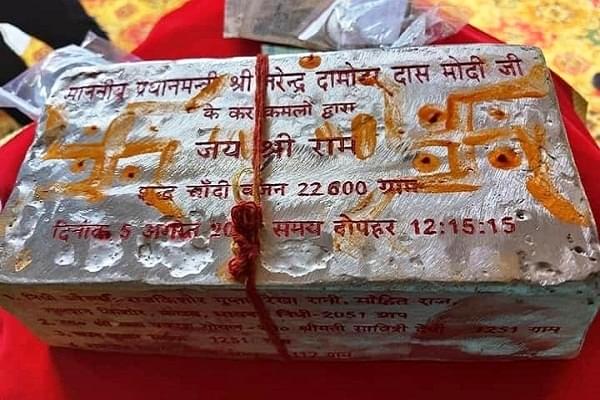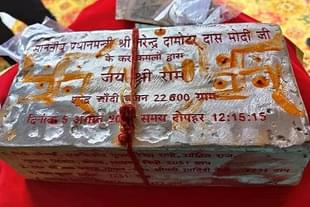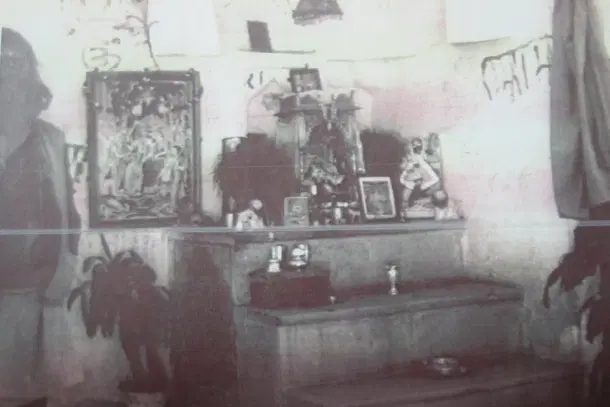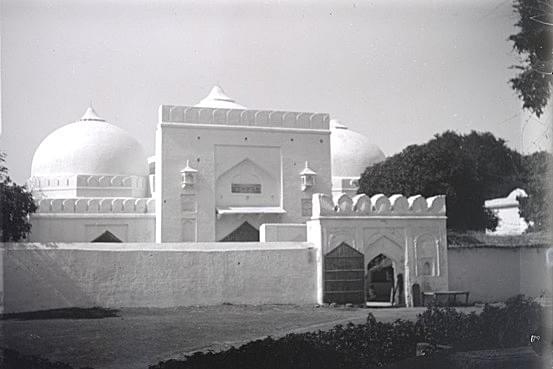Politics
Ahead Of Ram Mandir's Bhoomi Pujan, Here's A Brief History Of How The Battle Was Won In Indian Courts
Swarajya Staff
Aug 04, 2020, 10:29 AM | Updated 10:29 AM IST
Save & read from anywhere!
Bookmark stories for easy access on any device or the Swarajya app.


A three-day pooja began in Ayodhya yesterday ahead of the Ram Janmabhoomi Bhoomi Poojan.
It started with the worship of Sri Ganesha, and the kul-devatas (family dieties) of Sri Rama and Sita Devi. Today (Tuesday), special prayers will be offered at the Hanumangarhi temple, along with a special ‘nishan’ pooja.
As the faithful bask in the glory of the banks of river Saryu lit with diyas and the homecoming of Sri Rama, their beloved king, they also reminisce about the long, hard road to the Ram temple in Ayodhya.
The issue remain mired in legal wrangle for decades before the apex court, in a unanimous judgement, awarded the disputed. Here’s a short history.
1885: The first case related to the dispute was filed in January 1885 in the Court of the Sub-Judge, Faizabad, by Mahant Raghubir Das, regarded as the mascot of the temple movement.The case was filed against Lord Wodehouse, who was serving as the Secretary of State for India (responsible for the governance of British India) at that time. The mahant had requested permission to build a temple on the chabutara (a raised platform) outside the Babri Masjid. His plea was rejected.
1949-50: In a state of suspended animation since 1885, the dispute made headlines when an idol of Lord Ram appeared exactly at the proclaimed birthplace on the intervening night of 22 and 23 December 1949. This was followed by the pouring in of Hindu devotees and protests by Muslims. To keep the situation under control, the local administration declared the area as disputed and locked the gates.

This lead to Gopal Singh Visharad filing a case in the Faizabad civil court on 16 January 1950, seeking exclusive rights for performing puja and a permanent injunction prohibiting removal of the idol from the janmasthan. The court issued a temporary injunction and the order was later confirmed by a division bench of the Allahabad High Court. On 24 April 1950, the State of Uttar Pradesh, which had a Congress government led by Govind Ballabh Pant, appealed against the injunction order.
On 5 December 1950, Paramhans Ramchandra Das, head of the Ramjanmabhoomi Nyas (Rama Birthplace Temple Trust), an organisation linked to the Vishva Hindu Parishad (VHP), filed a cases seeking continuation of puja. However, he withdrew (dismissed as withdrawn) the case.
1959-61: On 17 December 1959, Nirmohi Akhara, one of the 14 akharas recognised by the Akhil Bharatiya Akhara Parishad, filed a case seeking possession of the site, claiming to be the custodian of the janmabhoomi and demanding the transfer of charge of the disputed site from the receiver.
On 18 December 1961, the Uttar Pradesh Sunni Central Board of Wakfs enters the fray along with nine Muslim residents of Ayodhya just days ahead of the expiry of the 12-year limitation period after which it would have lost claim to the site. It claimed the mosque and the adjoining land, and demanded the removal of the idols.

1986: On 1 February 1986, the district judge directed that the gates of the structure be unlocked for Hindu worshippers. The same year, Muslims set up Babri Masjid Action Committee to protest against the decision.
1989: Former VHP vice-president and a retired judge of the Allahabad High Court, Deoki Nandan Agarwala, filed a case on 1 July 1989 at the Lucknow bench of the Allahabad High Court in the name of Bhagwan Ram Lalla Virajman (Ram lalla). Making a reference to the 1928 edition of the Gazette of H R Nevill, the District Gazetteer of Faizabad, he claimed that Babur had destroyed the temple in 1528 and built a mosque in its place. On 14 August 1989, Allahabad High Court ordered maintenance of status quo at the site. The same year, Congress government at the Centre, led by Rajiv Gandhi, allowed the VHP to perform shilanyas ceremony, in which the first stone of the proposed Ram temple was put in place.
All the four suits were clubbed together and brought before the Allahabad High Court in 1989 on an application by the then Advocate General of UP.
1992: The structure at the disputed site was demolished on 6 December 1992. On 16 December that year, Justice Liberhan Commission was set up to inquire into the demolition of disputed structure and give a report within three months. President’s rule is imposed and Kalyan Singh's Bharatiya Janata Party-led government was dismissed. Three other BJP-led governments were dismissed soon after.
1993: Congress government at the Centre, led by P V Narasimha Rao, passed 'Acquisition of Certain Area at Ayodhya Act' on 3 April 1993 to acquire all the disputed areas (67.7 acres) under suits pending in the Allahabad High Court. Ismail Faruqui and various others filed petitions challenging the validity of the Act.
1994: The Supreme Court, on the question of acquisition of religious place by the government, decided that a mosque was not an “essential part of the practice of the religion of Islam” and that namaz could be offered anywhere, “even in open”, and hence, “its acquisition (by the state) is not prohibited by the provisions in the Constitution of India”. The government was allowed to include the 2.77 acres (on which the disputed structure once stood) in the 67.7 acres of land to be acquired under the Acquisition of Certain Area at Ayodhya Act, 1993.
1996: Allahabad High Court started recording oral evidence in July 1996.
2002-05: Three High Court judges began hearing the case in April 2002 to determine who the site belongs to and directed the Archaeological Survey of India (ASI) to excavate it to find if a temple existed in the area as claimed by the Hindus. The ASI begins work in June 2003 and found the claim to be true. The findings were rejected by the Muslim parties. In the same month, the Central Bureau of Investigation files a chargesheet against the then deputy prime minister, L K Advani, and seven others. In August 2003, court orders seven other leaders to stand trial while Advani does not face any charges being the country’s deputy prime minister.
In March 2003, the Supreme Court disallows all religious activity at the acquired land and states that the interim order should be operative till disposal of the suits pending in Allahabad High Court to maintain communal harmony.
In 2004, the Congress-led United Progressive Alliance came to power. Soon after, a court ruled that the order exonerating Advani should be reviewed.
2009: The Liberhan commission, which had been set up to probe the sequence of events leading up to the demolition of the disputed structure, submitted its report to prime minister Manmohan Singh after being granted 48 extensions.
2010: The Allahabad High Court, in its judgement on 30 September 2010, divided the disputed land into three parts ― one-third for the Sunni Waqf Board, one-third for the Nirmohi Akhara and one-third to the party for 'Ram Lalla’.
In December 2010, the Akhil Bharatiya Hindu Mahasabha and the Sunni Waqf Board challenged the High Court’s decision in the apex court.
2011: Supreme Court, in May 2011, stayed the High Court order to divide the land equally in three parts, stating that the status quo be maintained.
2016: Bharatiya Janata Party Member of Parliament Subramanian Swamy files plea in the Supreme Court on 26 February 2016 seeking construction of Ram Temple at the disputed site.
2017: On 21 March 2017, an out-of-court settlement was suggested by the then chief justice of India, J S Khehar. A three-judge bench was constituted by the Supreme Court on 7 August to hear pleas challenging the 1994 Ismail Faruqui verdict of the Allahabad High Court. The next day, UP Shia Central Waqf Board tells the apex court that a mosque could be built in a Muslim-dominated area at a distance from the site.
On 11 September, Chief Justice of the Allahabad High Court was directed by the Supreme Court to nominate two additional district judges as observers to deal with the upkeep of the disputed site within 10 days. On 1 December, 32 “civil rights activists” enter the fray with pleas challenging the 2010 verdict of the High Court.
2018: The Supreme Court started hearing civil appeals in February 2018. In March, it rejected all interim pleas, including Swamy's, seeking to intervene. In April, a plea was filed by advocate Rajeev Dhavan, who was representing some of the Muslim bodies, to refer the issue of reconsideration of the observations in the Ismail Farooqi (1994) judgement to a larger bench.
On 6 July, the UP government claimed that the other side wanted to delay the decision by seeking reconsideration to a larger bench. In September 2018, the Supreme Court declined to refer the case to a five-judge Constitution bench.
2019: CJI Gogoi constituted a five-judge constitution bench to hear the appeals. The Supreme Court appointed a mediation panel to resolve the issue. After mediation proceedings failed, the court began daily hearings in the case from 6 August.
9 November 2019: The Supreme Court has given its verdict in the Ramjanmabhoomi case. The land has been allotted to Hindus for the construction of the temple.Muslims are to be allotted a separate five-acre site at a prominent location in Ayodhya for the construction of a mosque.
Even as left ideologues continue to criticise and protest the Ram temple construction, it would certainly provide some healing to the wounds of the Hindus who have suffered historical crimes and persecution based on religious identity.
Watch: Dishonesty Of Leftist Historians In Ram Janmabhoomi Case Evident, It’s Time To Apologise





